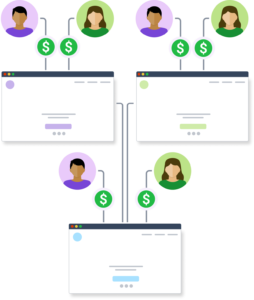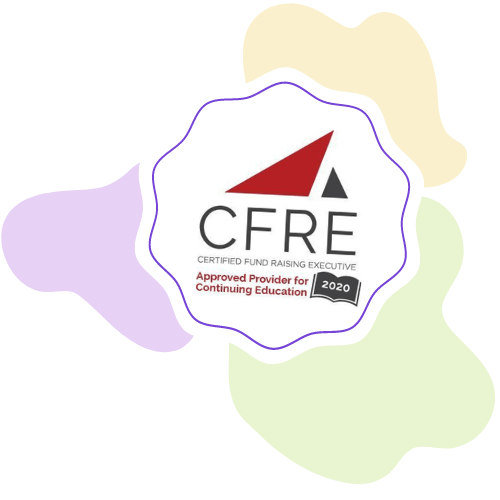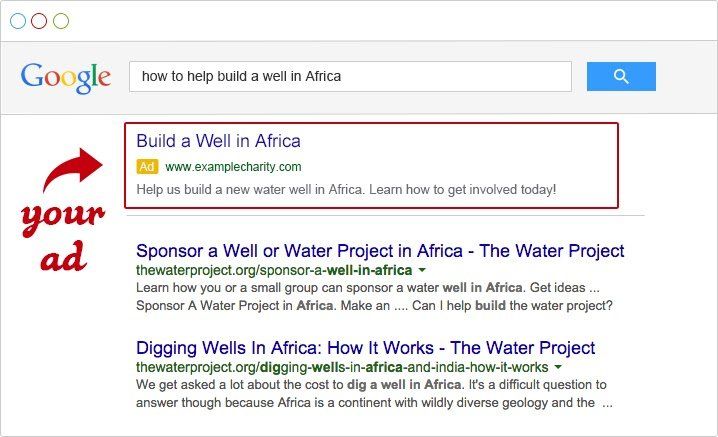Donor Acquisition Plan: How to Get More Donors Online


We devote a lot of bleeps and bloops to explaining how to get your donors to stick around, give again, donate repeatedly, and get back to giving after taking a break. And it makes sense.
Supporters who give more than once contribute more value to your mission than one-time donors. So it’s in your best interest to pursue and engage those donors, and it’s in our best interest to help you do it.
But where do those multiple, recurring, repeat, returning, and legacy donors come from? Well, a journey of a thousand miles begins with a single step. Or, in this case, a single donation.
With a donor acquisition plan, you can have a strategy in place for getting more donors and encouraging them to keep coming back.


Steal these 10 Email Templates to Boost Recurring Donations
Use these examples to create engaging stories,design beautiful emails, and raise more money.
Why Donor Acquisition is Critical to Your Success
There are two ways to look at new donor acquisition and its importance: incoming and outgoing.
Incoming donors, which is to say, supporters who have given one time, are your best target audience for donor cultivation and engagement strategies that seek to create repeat and lifelong givers. Without new donors coming into your system, there is no one to convert into the much more valuable recurring donor that all nonprofits lust after.
Outgoing donors are supporters who have given in the past but, for one reason or another, have stopped giving and will never give again. So even though you put all the work into courting potential donors and transforming them into regular, annual, or monthly supporters, they’re gone now, and you’ve got to replace them with somebody. So you better figure out how to attract new donors.
It’s about keeping your pipeline stocked with enough donors in various categories (first time, recurring, major, legacy, etc.) to ensure your revenue stream aligns with your world-changing programs and projects. And it begins with finding prospective donors and convincing them to give the first time.
7 Surefire Donor Acquisition Strategies
Donor acquisition is not a “put all your eggs in one basket” situation. There is no single way or place to find new donors. A multi-pronged approach that uses various channels to reach different donor demographics is always going to serve you better than just hammering the same audience using the same old method.
We’ve put together a survey of reliable options to get you started, though it’s, of course, up to you to identify what will work best for your specific organization. And feel free to add and adapt according to your needs.
1. Social Media Marketing
One of the fastest, cheapest, and most effective ways to find new donors is via your social media channels. After all, as of writing this, Facebook has 2.7 billion users. Where else are you going to find that many people who might be open to your message?
The best strategy for social media is to create meaningful content that is useful and engaging to your audience. Piquing their interest in something related to your mission makes it easier to drive them toward your website where they can engage further with your organization (more on that later).
In addition to the people you reach directly on social media, you should also prioritize indirect views, which is to say, sharing. The magic of the internet allows your content to take on a life of its own as it is liked, commented on, and shared between people and across channels, exponentially amplifying your message and hopefully gathering lots of new potential donors.
And if you have a small budget devoted to your social media acquisition strategy, you may want to look into boosting your posts to reach even more prospects.
2. Peer-to-Peer Fundraising
Another way to capitalize on social sharing is a peer-to-peer campaign. Peer-to-peer fundraising involves hosting an event, often a bike ride or walk, and signing people up to fundraise on your behalf. They share your message via social media with their networks, who may never have heard of your mission before.
Those who give to your cause also share their email addresses, opening them up to email marketing campaigns in the future. Those who don’t give have at least heard about your organization and may be interested in giving sometime down the road. And according to this report, each share is worth $15 on average, so if your peer-to-peer campaign manages to spread far and wide, you’ve also raised some helpful revenue.
Facebook also offers some online fundraising tools like Facebook Fundraisers, which may or may not suit your needs.
With Keela’s Peer-to-Peer fundraising tool, you can reach and engage a wider network of donors and supporters. This tool allows your supporters to fundraise on behalf of your nonprofit. Using Keela’s highly customizable peer-to-peer fundraising pages and optimized donation forms, your supporters can spread the word about your campaign, raise money and track their progress. Such a collective effort goes a long way to helping your organization meet its fundraising goals.


Reach More Supporters with Keela’s Peer-to-Peer Fundraising Tool
Your supporters can now fundraise with you! Using Keela’s NEW peer-to-peer fundraising tool, supporters can create and share customizable fundraising pages to raise money for your nonprofit’s campaigns.
3. Facebook Advertising
Advertising on Facebook is a rabbit hole. With the incredible breadth of options and billions of users in different demographics, it can be easy to get a little lost. But for not too much money, you can get an ad in front of a lot of people, some of whom may give to your cause or at least check out your website. Just be sure to read up on the service before jumping in with both feet.
Facebook also offers a feature called Lookalike Audiences that helps you advertise to people who match specific key characteristics found in your current donors. This means that potential donors will be more receptive to your message than a broad cross-section of the population.
Many social networks and other internet services also offer retargeting. So if a potential donor sees your ad or your website and doesn’t give, you can give them a nudge later on with follow up ads that recapture their interest.
4. Google Ads
Maybe the only place on the internet where you can reach more people than Facebook is Google. And there is a reason Google is free for you to search for exciting new cat gifs: advertising. They have to make money somehow, right?
Advertising with Google can put your brand and mission in front of vast numbers of people, funneling them toward your website and donation page. It does cost money, but the potential payoff may be worth it depending on your situation. Also, if your organization is eligible, just kidding, it’s free! There is also an excellent explainer video on how to get started with Google Grants, but the gist is that you can get up to $10,000 in ads for free.
Google offers two types of ads: search and display. Search ads are the fundamental ads that show up at the top of your Google search results. They can be identified by a small “Ad” tag before the URL but otherwise, look like a search result. Search keywords trigger this type of ad, so the SEO on your website needs to be solid.
Display ads are more visual and generally in the form of banner advertising and appear on websites across the web. The graphic nature of these ads makes them ideal for showing off your brand to potential donors, who may not click these ads—the idea being that when they see more mentions of your organization later on, perhaps on social media, they’ll be primed to engage.


Build Your Google Ads Campaign with this FREE Planner
Imagine Canada and Keela have created this free guide, planner, and template to help you navigate Google Ads campaigns.
5. YouTube Ads
As a subsidiary of Google, YouTube employs a very similar advertising system, though, in this case, your ads can be video, not just text and/or images. YouTube ads appear next to videos, before videos, and frustratingly, in the middle of that video that you’re watching on how to fix the dishwasher (just show me how the filter goes back in!)
If you have the resources to create video advertisements, this may be a good option for you since people “retain 95% of a message when they watch it in a video” instead of only 10% for text.
Check out these examples of great nonprofit video ads for inspiration.
6. Organic Traffic
The goal of all of your social media ministrations and advertising activities is to push potential donors to your website. But if they get there and it looks like a Geocities site circa 1994, you’re going to have a problem. Your site needs to be easy to navigate, filled with useful info, nice to look at, and it needs to encourage people to visit your donation page.
a. Donation Page
Your donation page is where the rubber meets the road. This is where all of your efforts up to this point lead. You’re asking people to get their wallets out and commit to a donation. But if they get there and your donation page is confusing or not what they were expecting, you can expect many bounced potential donors.
This post is an excellent look at donation page best practices (with examples!). The most important thing is to ensure your donation page offers a great mobile experience—more than 50% of web traffic is now via mobile devices.


17 Tips For Creating the Perfect Donation Page [Checklist]
Every last details matters to convert visitors into donors. Use this checklist to create the perfect donation page.
b. SEO Marketing
Search engine optimization, or SEO, is the process of including specific, high-ranking keywords on your site to encourage more visible placing in search results. Good SEO allows more people to find your website when searching for things related to your cause. This one is super simple: higher placement in search results means more website traffic and more potential donors. Easy.
7. Email Marketing
There is no denying that emails are a useful tool for nonprofit organizations. For every email sent, nonprofits earn $45, on average. And nonprofits enjoy a particularly advantageous position when it comes to recipients actually reading your emails. So why not use email to acquire new donors?
Start by building contact lists from email addresses that you’ve collected from events, through your website, newsletter subscriptions, or anywhere else you might have received contact information. If you have an extensive list, consider segmenting it and customizing your email for each segment.
Here is a good look at how to write a solid solicitation email, but the short version is:
- Send emails at the right time for your audience.
- Make content relevant.
- Don’t send too many emails.
Not so bad, right? Moving on.
If you have a bunch of email addresses in your contact list for people who have shown interest but not yet given, it’s time to craft a delicious welcome email. Welcome emails help to bring new potential supporters into the fold, further explain your mission and begin to engage with them in hopes that they will donate.
You may choose to write one excellent welcome email. Or you may want to write a series of emails (called a drip campaign) that nurtures your new audience and gently guides them toward donating. Either way, once you’ve welcomed your new followers, it’s time to do some content marketing.
Similar to the content you put on social media, your website’s content should be engaging, interesting and should work toward building a deeper relationship with your audience.
Share valuable information on your blog. If it’s a great piece of content, you might consider gating it, which is when you offer it via your website and on your social media channels in exchange for someone’s email address. In this way, your contact list grows, helping future email campaigns to reach further. And if you’d like to automate the process, there are plenty of tools to help you do it.
Go Deeper
Now that you’ve read up on the basics if you’re thirsty for more online fundraising ideas that can help you find new donors to bolster your ranks, take a spin through The Complete Guide to Online Fundraising Ideas.
See How Nonprofits Use Keela to Collect Online Donations
Get a glimpse of how Keela’s fundraising smart tools help nonprofit organizations to strategize, streamline, and automate their fundraising efforts.
7 Donor Acquisition Best Practices
In addition to the specific tools you employ to help acquire new donors, there are some generally accepted best practices that you can apply across the board to ensure your message is well received, that your organization appears to be trustworthy, and that you are getting the biggest bang for your buck.
1. Be Transparent
Donors want to know where their money is going and what it is specifically being used for, so go ahead and tell them upfront. It helps eliminate hesitation at the moment before they click DONATE and builds long-term trust and rapport.
2. Understand Your Donors
Use donor personas to identify your ideal audience and target the right people with the right strategies. This should be part of your larger donor management strategy too.
3. Set Goals
“Find more donors” is not a goal. When setting out on your acquisition journey, set goals that are specific and based on numbers that you already know. If you acquired 1,000 new donors last year, a 10% increase would be reasonable, but acquiring 10,000 new donors probably isn’t. Goals help to keep your eyes on the prize and understand how you’re doing throughout your campaigns.
4. Track and Measure
How are you going to set achievable goals if you don’t track your numbers? Reliable data helps you understand where your successes and failures happened and what to do better next time. Consider adding fundraising reports to your to-do list, and set some KPIs to give you an overview of how you’re doing in especially important areas.
5. Understand Cost
As part of your tracking and measuring, don’t forget to watch your cost per acquisition. Simply put, if it costs you $5 to raise $5, you’re doing it wrong.
6. Try Direct Mail
Some segments of the population still love to get a letter in the mail, so why not try direct mail? It has many advantages that you may not have considered, and we even have a handy post on how to write a donation letter, so you’re all set.
7. Watch Your Calendar
Many people are more likely to give during certain times of the year, particularly the end of the year and Giving Tuesday, so it’s good policy to ramp up your acquisition efforts during these times. People are in the giving spirit and may be more receptive to your message.
How to Engage New Donors
Great, sit back and collect all the donations and kudos that are rolling in, right? Not so much.
Remember that the first donation is only the beginning of your relationship with your donors. Start mapping out donor journeys for your new audience, so you know where they’ve been, where they are, and where they’re going on their path with your nonprofit organization. And if you need a little help keeping those relationships fresh and donations coming in, we’ve got you covered.


Ready to take your acquisition strategies even higher?
Enroll in Keela U, a 9-Chapter, FREE Fundraising Course dedicated to nonprofit professionals looking to expand on their skills. Not only will you master donor acquisition, but you will earn 15 CFRE credits upon completion.



